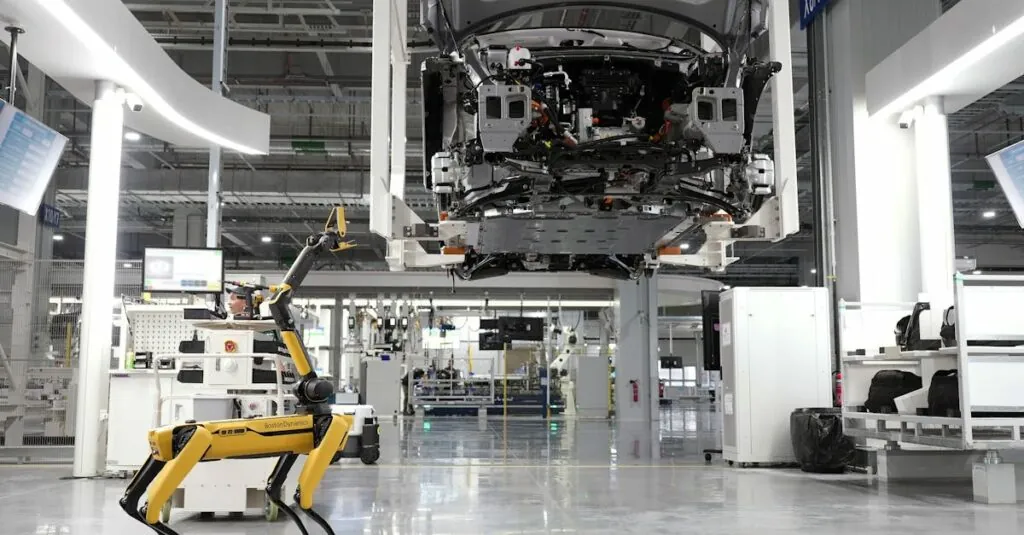Table of Contents
ToggleIn a world where your fridge can remind you to buy milk and your thermostat knows when you’re feeling chilly, sensors are the unsung heroes of the Internet of Things (IoT). These tiny gadgets gather data faster than you can say “smart home,” turning everyday devices into tech-savvy companions. They’re like the superheroes of the digital age, working silently behind the scenes to make life smoother and more efficient.
Overview of Sensors in IoT
Sensors play a vital role in the Internet of Things (IoT) by gathering various types of data from their environment. Measuring temperature, humidity, light levels, and motion, these devices contribute significantly to smart technology. Smart thermostats, for example, utilize temperature sensors to adjust heating or cooling according to user preferences and real-time conditions.
Many IoT applications rely on sensor data to function efficiently. Environmental monitoring systems use air quality sensors to detect pollutants, providing valuable feedback for maintaining safer living conditions. Similarly, agricultural IoT solutions implement soil moisture sensors to optimize irrigation practices, ensuring crops receive adequate water without wastage.
These sensors often connect wirelessly to networks, transmitting data for processing and analysis. This connectivity enables real-time decision-making, which enhances the functionality of various applications. Smart home systems utilize motion sensors to activate security alarms, and they also manage home lighting automatically based on occupancy.
Different types of sensors cater to diverse industries. Industrial IoT employs vibration sensors to monitor machinery health, reducing maintenance costs and preventing breakdowns. Wearable health devices, equipped with heart rate and activity sensors, help individuals track their fitness levels and well-being continuously.
The advancements in sensor technology correlate directly with the growth of IoT. Miniaturization of sensors enhances their integration into everyday devices, leading to increased functionality and smart capabilities. As sensors evolve, they contribute more profoundly to making everyday tasks more efficient and convenient.
Types of Sensors in IoT
Various sensors play pivotal roles in IoT applications. Each sensor type contributes unique functionalities essential for smart ecosystems.
Environmental Sensors
Environmental sensors monitor factors like temperature, humidity, and air quality. These devices enhance applications in agriculture by ensuring optimal conditions for crops. Smart thermostats rely on environmental sensors to provide precise climate control, adjusting heating and cooling based on real-time data. Pollution levels become easier to track with air quality sensors, aiding in public health initiatives. Moreover, smart buildings utilize temperature and humidity sensors to regulate energy consumption efficiently.
Motion Sensors
Motion sensors detect movement within a given area. These devices find extensive applications in security systems by alerting homeowners to unauthorized access. Automated lighting systems enhance convenience by activating lights when motion is detected. In smart health applications, motion sensors track user activity levels, promoting healthier lifestyles. Wearable fitness devices incorporate motion sensors to monitor steps and physical activity, providing valuable insights into personal health metrics.
Proximity Sensors
Proximity sensors identify the presence of objects nearby without direct contact. Automated doors in retail and commercial spaces use proximity sensors for hands-free access, improving customer experience. Additionally, parking sensors in vehicles prevent collisions by detecting nearby obstacles. These sensors facilitate efficient use of resources in industrial applications by automating machinery operations. Smart devices leverage proximity sensors to enhance user interaction, allowing seamless connections to smartphones and other devices.
Applications of Sensors in IoT
Sensors play an integral role across various industries, enhancing functionality and efficiency.
Smart Homes
Smart home technology thrives on sensors. Temperature sensors adjust heating and cooling based on real-time conditions. Motion sensors enhance security by detecting unusual movements and automating lighting. Additionally, smart appliances use light sensors to optimize energy consumption. These innovations contribute to convenience and energy savings for homeowners.
Healthcare
Healthcare applications leverage sensors to improve patient care. Wearable devices monitor vital signs like heart rate and blood pressure in real-time. Environmental sensors alert patients about air quality, which can affect respiratory conditions. Remote monitoring systems utilize these sensors to provide healthcare professionals with data. Collectively, these advancements promote proactive health management and enhanced patient outcomes.
Industrial Automation
Industrial automation benefits significantly from advanced sensor technologies. Vibration sensors monitor machinery for signs of wear or potential failure, enhancing maintenance plans. Temperature sensors ensure optimal conditions in manufacturing processes, reducing waste. Proximity sensors streamline operations by assisting with automated tasks and improving worker safety. Overall, these applications foster greater efficiency and productivity in industrial settings.
Challenges in Implementing Sensors in IoT
Implementing sensors in IoT poses several challenges that need addressing for effective integration into systems.
Data Privacy Concerns
Data privacy emerges as a significant issue in IoT sensor deployment. Sensors collect personal information, such as user behavior and location data, which might lead to unauthorized access if not properly secured. Companies must ensure robust encryption measures to protect this sensitive information from breaches. Transparency becomes crucial in notifying users about data collection practices. Organizations also face regulatory compliance challenges, as various laws, like GDPR, impose strict requirements on data handling and storage.
Integration Issues
Integration issues often arise when connecting sensors with existing IoT systems. Diverse sensor types and protocols create compatibility challenges, making it difficult to create a unified platform. Standardization efforts across the industry might help mitigate these issues, but widespread adoption remains slow. Furthermore, technical expertise is vital for seamless integration, and the lack of skilled personnel can delay projects. Interoperability between different devices and networks complicates system performance, leading to inefficiencies that affect overall functionality.
Future Trends in Sensors for IoT
Emerging trends in sensor technology promise to transform IoT applications significantly. Increased miniaturization stands at the forefront of these advancements, enabling sensors to integrate seamlessly into everyday devices. Enhanced accuracy illustrates the ongoing development of sensor capabilities, allowing for more precise data gathering across various environments.
Artificial intelligence (AI) integration offers the potential for smarter data analysis from sensor outputs. AI algorithms can process large volumes of data, extracting insights and improving real-time decision-making. Advanced energy harvesting techniques are also on the rise, allowing sensors to operate on minimal power. These innovations lead to longer device lifespans and reduced reliance on battery replacements.
The growth of 5G connectivity influences sensor functionality as well. Low latency provided by 5G networks enhances data transmission speeds, enabling sensors to communicate effectively and efficiently. A shift toward edge computing equips devices to process data locally, reducing the need for centralized data storage and enhancing response times.
Smart cities embrace these sensor trends, using them to manage everything from traffic flow to environmental monitoring. Smart waste management systems rely on sensors to optimize collection routes based on real-time data, promoting sustainability. Retail environments also benefit as sensors track inventory levels and customer behaviors, leading to improved shopping experiences.
Healthcare applications advance through wearable sensors that continuously monitor vital signs and alert users to potential health issues. Improved data privacy measures are crucial for gaining user trust, addressing concerns about security and data integrity. As innovation accelerates in IoT sensors, industries across the board will adopt these emerging technologies, driving further development and resource efficiency.
Sensors in IoT are transforming the way people interact with technology. Their ability to gather and analyze data enhances not just everyday appliances but entire industries. As advancements in sensor technology continue to emerge, the potential for smarter applications grows.
Addressing challenges like data privacy and integration will be crucial for the future of IoT. The ongoing development of standards and security measures will help ensure that users can trust these systems.
With the integration of AI and improved connectivity, sensors will play an even more significant role in shaping efficient smart ecosystems. This evolution promises to create a more connected and responsive world, benefiting everyone from homeowners to industrial operators.







